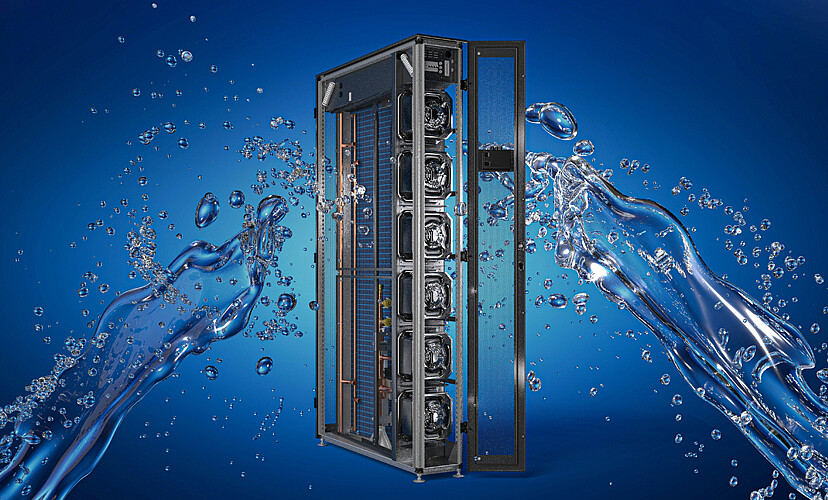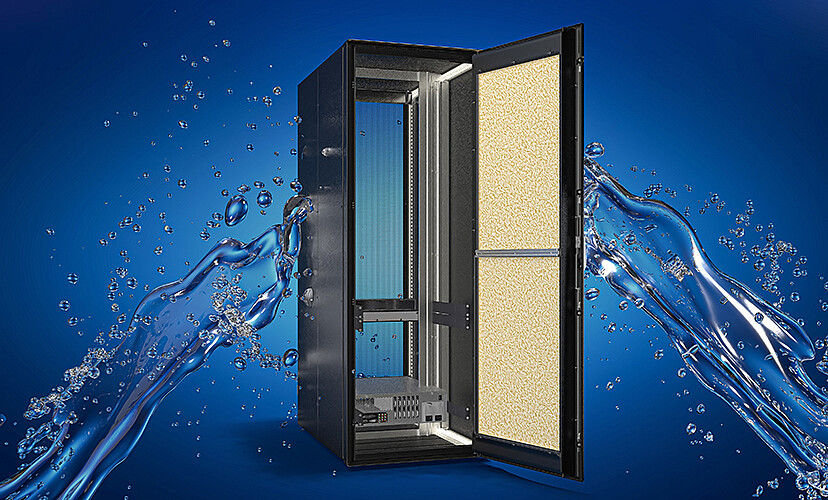Topics
For the operation of any data centre, efficient cooling is a core issue – but how can it still be achieved, if you want to do without climate-damaging coolants like R410 A? And in future that will have to be the case, because the new F-gas regulation has banned their use. SCHÄFER IT-Systems shows how cooling with cold water can be implemented economically in systems with a capacity of up to 50 kW.
Energy management has long been one of the central tasks of a modern data centre, but it’s now no longer simply a matter of efficiency and controlling costs, it’s a global challenge. Climate protection has become a dominant issue on almost all levels of business and society. Consequently it’s not just knocking on the doors of data centres; It’s already found its way right into their core.
Up to now, for smaller and medium-sized solutions – by which we mean data centres with heat dissipation capacities of up to 50 kW – economic considerations have been the first priority: the first question was always how the data centre could be operated as cost-effectively as possible, even before considering operational reliability and – normally last of all – any environmental impact. So, environmentally friendly cooling solutions such as cold water were scarcely taken into account at all, as they were thought to be the worse choice in terms of operating costs. At the same time, however, the benefits associated with cold water cooling, such as easy servicing and energy efficiency, weren’t given the appreciation they deserved.

The new F-gas regulation forces data centre operators to fundamentally rethink their entire cooling approach, even in the range up to 50 kW. This is because using coolants with a GWP (Global Warming Potential) of more than 2,500 in new stationary systems will be completely banned from 2020 – and from 2025, this ban will apply from a GWP of over 750. The GWP expresses the warming effect of a substance in relation to CO2, or more precisely, the factor by which the substance contributes more to the greenhouse effect than a kilogram of CO2 within the first 100 years after its release to atmosphere. For the coolant R 410 A, this value is 2,088, roughly equivalent to the effect of two tons of CO2. There will therefore be a complete and binding ban on this substance from 2025.
Besides the imminent ban on R 410 A, a drastic effect on price can be expected for this coolant, and is already becoming apparent, as the amount available on the market is being systematically reduced year by year, resulting in significant price increases, possibly as much as 45 % over a very short period of time. This year (2019), only around 63 % of the amount traded in 2015 will actually be put into use, while experts estimate that in 2024, this will have dropped to only 31 %.

For various reasons, the use of alternative coolants in new systems is therefore inevitable and for a number of quite different reasons, the coolant of choice seems to be water. Though the coolant R32 is available as a possible replacement for R410A in the range up to 14 kW, it does have some significant drawbacks, such as high flammability and the need for special equipment during installation.
Cold water has none of these drawbacks and, at the same time, the cold water cooling process has proven very effective for decades (in mainframes, for example) and has since been continuously refined and its performance optimised. Today, for instance, new server technologies can achieve outputs of up to 100 kW per cabinet. An intelligent rack cooling solution, such as the one offered by SCHÄFER IT-Systems, operates directly at server level to absorb the heat at its point of origin, namely the server itself, and dissipate it via cold water pipes.
Close cooperation between manufacturers of server solutions and climate control specialists would seem to be an obvious approach here, especially in the fields of operational reliability and scalability – after all, it’s essential to keep track of all future developments.

This would include possible uses for waste heat, arising, for example, from the field of university-based scientific computing, which permanently generates uniform levels of heat. Warm water cooling (from 55 °C) can also be used and the waste heat generated can then be taken for heating lecture rooms or libraries.
For rack-based cold water cooling in data centres there are already many different solutions available enabling the heat exchangers to be placed wherever they suit the available conditions best: at the side, inside the rack or directly on the rack. Excellent results can be achieved here, especially in the range up to 30 kW, while working with a cold water flow temperature of around 15-20 °C.
Cold water, however, has also proven itself in edge computing or in mobile data centre solutions (containers, for instance). For performance classes from 5 kW upwards, there are extremely efficient cooling solutions available today, which can justify their investment costs in the shortest possible time. The current range of applications for cold water cooling is almost unlimited and the efficiency levels attained by this environmentally friendly method are high enough to make any data centre manager sit up and take notice. So now, it finally is possible to have the best of both worlds; environmental protection and cost-efficiency.